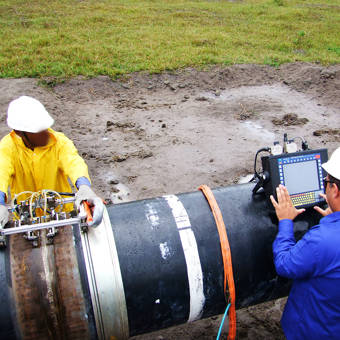Shield Your Financial Investment: Thorough Pipeline Welding Inspection for Peace of Mind
Shield Your Financial Investment: Thorough Pipeline Welding Inspection for Peace of Mind
Blog Article
Comprehensive Introduction of Pipe Welding Assessment Treatments
Pipeline welding inspection procedures play a crucial function in ensuring that welded connections satisfy strict market requirements and requirements. From meticulous pre-welding evaluations to extensive post-weld analyses, a distinct examination procedure is important for keeping the architectural stability of pipelines.
Pre-welding Evaluation Preparations
Prior to beginning the welding procedure, thorough pre-welding evaluation prep work are necessary to ensure the honesty and high quality of the weld joint. These prep work entail a careful examination of the products to be bonded, the welding tools, and the work atmosphere. By performing detailed pre-welding assessment prep work, potential concerns can be determined and solved early on, leading to top notch and reputable weld joints.
Welding Procedure Qualification
Extensive pre-welding evaluation preparations lay the foundation for the essential process of Welding Procedure Credentials, ensuring the integrity and top quality of the weld joint. Welding Treatment Certification (WPQ) is a vital action in the welding procedure that includes testing and accrediting welding treatments to assure they fulfill particular criteria and requirements. The WPQ procedure generally consists of welding treatment specification development, welding procedure credentials screening, and documents of the outcomes.
During welding procedure specification growth, important information such as the welding process, welding materials, joint layout, and welding specifications are defined to develop a comprehensive treatment. Subsequently, welding procedure credentials screening is conducted to confirm the suggested procedure's stability. This screening commonly includes welding test discount coupons that undergo different mechanical and non-destructive tests to assess the weld's quality and adherence to the defined requirements.
In-process Weld Examination
During the welding procedure, in-process weld assessment plays a crucial role in ensuring the high quality and stability of the weld joint - Pipeline Welding Inspection. This type of assessment includes keeping track of the welding criteria, evaluating the weld bead development, and identifying any type of prospective flaws or stoppages as they happen. By carrying out in-process weld inspections, welding operators can without delay resolve any issues that may emerge, thus protecting against more issues and making certain that the last weld fulfills the required specifications
Common techniques utilized for in-process weld evaluation consist of visual assessment, fluid penetrant testing, magnetic fragment testing, ultrasonic testing, and radiographic screening. Overall, in-process weld assessment is essential for preserving the top quality and reliability of bonded pipes.
Non-destructive Testing (NDT)
Non-destructive Testing (NDT) is an essential technique utilized in pipe welding evaluation to examine the integrity of weld joints without triggering damage to the bonded framework. By utilizing various NDT methods, assessors can review the quality of welds and determine any type of issues or gaps that might endanger the blog architectural strength anonymous of the pipeline. Common NDT approaches made use of in pipeline welding evaluation include Radiographic Screening (RT), Ultrasonic Screening (UT), Magnetic Fragment Evaluating (MPT), Fluid Penetrant Screening (LPT), and Visual Testing (VT)
RT involves using X-rays or gamma rays to create photos of the inner framework of the weld, permitting inspectors to spot defects such as porosity, cracks, or insufficient blend. UT utilizes high-frequency acoustic waves to find imperfections underneath the surface of the weld, offering thorough details about the size and area of flaws. MPT and LPT are utilized to determine surface-breaking flaws by applying magnetic particles or penetrant liquids to the weld area. Furthermore, VT includes visual inspection of welds to identify any kind of noticeable flaws.
Post-weld Assessment and Paperwork

Paperwork of post-weld evaluation findings is necessary for preserving quality assurance documents and making sure compliance with sector standards and laws. In-depth reports should include details regarding the evaluation approaches utilized, the area and nature of any type of issues discovered, and any kind of corrective activities taken - Pipeline Welding Inspection. Correct documentation not just functions as a document of the weld's high quality however also aids in future upkeep and inspection processes
Verdict

Finally, pipeline welding assessment treatments play an essential role in making sure the high quality and integrity browse around this web-site of welds. From pre-welding inspections to post-weld paperwork, each step is vital in keeping the safety and security and efficiency of pipes. By complying with well established treatments and conducting extensive examinations, prospective problems can be identified and addressed prior to they result in costly repair work or failures. Overall, adherence to correct inspection procedures is key to the success of pipe welding projects.
From precise pre-welding evaluations to extensive post-weld evaluations, a well-defined evaluation process is crucial for keeping the architectural strength of pipelines. By carrying out in-process weld evaluations, welding operators can promptly address any kind of concerns that might emerge, therefore protecting against more flaws and making sure that the final weld satisfies the required specs.
Typical approaches used for in-process weld evaluation include aesthetic evaluation, liquid penetrant screening, magnetic bit testing, ultrasonic screening, and radiographic testing.Non-destructive Screening (NDT) is an essential technique employed in pipe welding assessment to evaluate the honesty of weld joints without triggering damage to the bonded framework. Post-weld inspection entails different approaches to examine the welds for defects, consisting of visual examination, dye penetrant screening, magnetic bit screening, ultrasonic testing, and radiographic screening.
Report this page